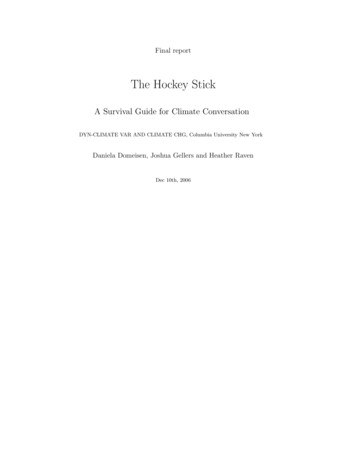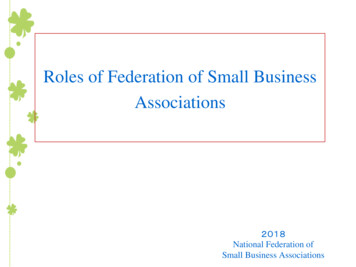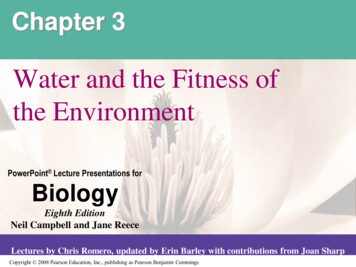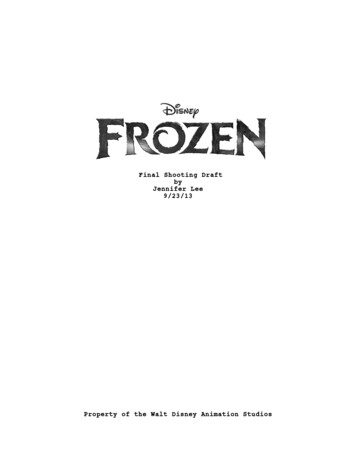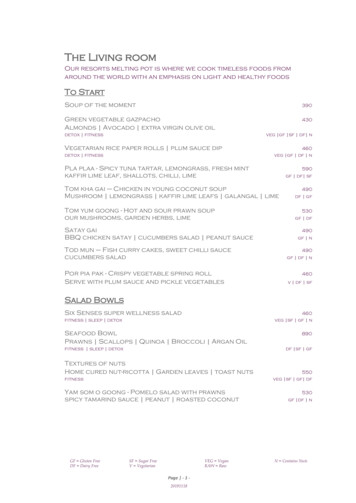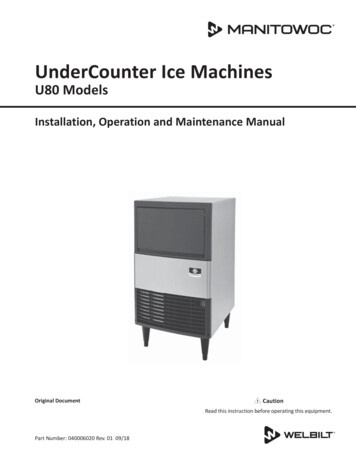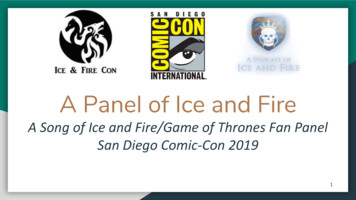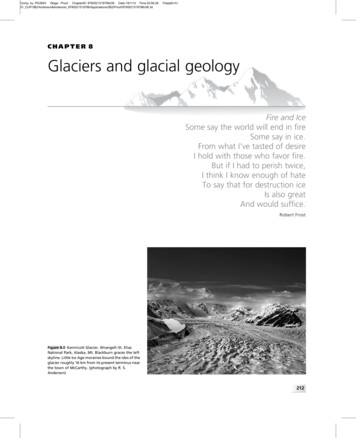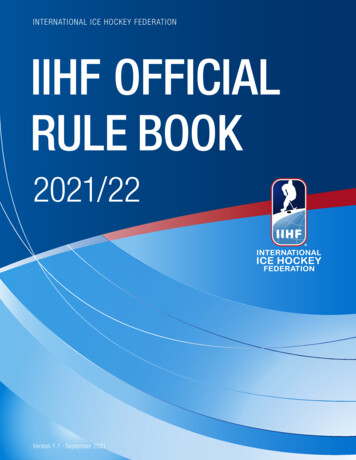
Transcription
INTERNATIONAL ICE HOCKEY FEDERATIONIIHF OFFICIALRULE BOOK2021/22Version 1.1 · September 2021
IIH F O F F I C I A L R UL E BOO K 2 0 2 1 /2 2WELCOMENo matter where ice hockey is played, the object of the game is the same - to put the puck intothe opponent’s goal. Beyond that, ice hockey across the globe is subject to certain variations. Thismakes the rules of the game extremely important. These rules must be followed all times, in allcountries, in all age categories, for the game to be enjoyed by everyone.Hockey’s speed is one of the qualities that makes it so exciting. But this skill and excitement mustbe balanced with fair play and respect.It is, therefore, important to make a clear separation between the purpose of all the elements of thegame and to use these respectfully. These distinctions can be taught at an early age or wheneverone begins to show interest in the game. And this is why hockey development begins with parentsand coaches, those people most influential in guiding a person, old or young, into playing the gameproperly and within the rules.The IIHF Championship program encompasses 81 Member National Associations, five age andgender categories over 30 international ice hockey tournaments, including the Olympic WinterGames.The extensiveness of the program is acknowledged in the rule book. The goal is to provide everyoneone set of rules from which to work. This presents a fair and leveled standard of play. It is a meansof keeping the game’s “language” the same regardless of where it is played.INTERNATIONAL ICE HOCKEY FEDERATIONTABLE OF CONTENTS2
IIH F O F F I C I A L R UL E BOO K 2 0 2 1 /2 2GENERAL INFORMATIONCOPYRIGHTAll rights reserved. The use of any part of this publication reproduced, transmitted in any form orby any means – electronic, mechanical, photocopying, recording, or otherwise – or stored in aretrieval system, without the prior written consent of the International Ice Hockey Federation is aninfringement of copyright law. The scanning, uploading, and distribution of this publication via theinternet or any other means is illegal.OFFICIAL LANGUAGEThe IIHF publishes the Rule Book in English. Translations into different languages are usuallyorganized by the individual Member National Associations. If there is any divergence in the wording,the English text is authoritative.OTHER LANGUAGESMember National Associations (MNA’s) which produce a translated version of the IIHF Rule Bookusing this format are invited to send a copy to IIHF (stating clearly on the front cover that it is thatMNA’s official translation) so it can be posted on the IIHF website for use by others.NAVIGATION IN THE RULE BOOK Rule Book internal Links» References to Rule Book external DocumentsQUESTIONS OR REMARKS?Do you have any questions, suggestions, or remarks about this Rule Book - please contact usat rulebook@iihfoffice.com.Version 1.0 confirmed June. 5th 2021 IIHF Annual Congress Riga, Latvia.Version 1.1 September 2021.TABLE OF CONTENTS3
IIH F O F F I C I A L R UL E BOO K 2 0 2 1 /2 2OUR VALUESSOLIDARITYThe rules are the basis for understanding the game, and the key tool for a player, coach, orassociation to explain and develop skills. The rule book can be understood as a common language, which we can use to communicate in standard way, making the sport as fair as possible.4
IIH F O F F I C I A L R UL E BOO K 2 0 2 1 /2 2OUR VALUESINTEGRITYIce hockey is a team sport. No matter how great an individual player is, his or her teammatesare essential to the team’s success. This is also what makes ice hockey so special. Apart fromthe physical skills required, it teaches values such as selflessness, team play, character, heart,dedication, leadership, and respect.The rules of ice hockey start with respecting the sport itself. This means complying with all rulesregarding doping and match-fixing. It also means respecting coaches and officials, and playingwithin the boundaries of the on-ice code of conduct.5
IIH F O F F I C I A L R UL E BOO K 2 0 2 1 /2 2OUR VALUESSKILLSIce hockey is the fastest and most thrilling of all team sports because it is a combination of twosports – skating and hockey. Skating is a complex skill but also very enjoyable, while the skillsinvolved in playing hockey take dedication and practice to master.Skating requires strength, balance, and stamina. Once a player masters the ability to skateBackwards and Forwards, to turn and stop quickly, to get around a player or avoid a bodycheck,the enjoyment of the game truly grows.Ice hockey consists of three basic skills – stickhandling, passing, and shooting. Stickhandlingrequires superb hand-eye coordination, the ability to cradle a puck and feint an opponent at theright moment. Passing requires vision, timing, and anticipation. Shooting requires practice andstrength and technique.What makes ice hockey so special and challenging is that a player must learn to combine thosethree essential hockey skills with the completely different skill of skating. It is two sports, notone, but when combined, this makes an incredible enjoyable experience.6
IIH F O F F I C I A L R UL E BOO K 2 0 2 1 /2 2OUR VALUESPASSIONThe passion for ice hockey exists everywhere, from the players to coaches, from parents to officials, to fans and volunteers. Hockey cannot exist without this passion. It is a spark, one that canignite the moment you pick up a stick and hit the ice for the first time. Whenever that momenthappens, whether you are a child or an adult, it remains a part of you for life.7
IIH F O F F I C I A L R UL E BOO K 2 0 2 1 /2 2OUR VALUESDISCIPLINE & RESPECTEveryone wants to win but winning at all costs can show a lack of respect for the game. Respecthas nothing to do with the puck or the opposition goal. It is about humanity. It is about ensuringthat every person can play in a safe and enjoyable environment, regardless of their skill level,size, shape, race, gender, sexual orientation, or beliefs.It is about encouraging people of all colors and religions, from all countries and all backgrounds.It is about including, not excluding, about celebrating, not denigrating. Hockey is a celebrationof teamwork and opportunity and meeting a challenge together. That is the obligation of everyone who plays the game – keep the game safe and fair!8
IIH F O F F I C I A L R UL E BOO K 2 0 2 1 /2 2OUR VALUESPRINCIPLES OF THE GAMENo proper game can be played without the Game Officials (Referees and Linespersons), andthey must command the respect of all players, coaches, parents, and associations involved atall levels of play.To love ice hockey and to want to play ice hockey starts with showing respect for the GameOfficials who oversee the game. They have spent years developing their skills, which includebeing as good a skater as the players. As well, they have had to hone their own subset ofskills - quick movements to stay out of the way of play, understanding and interpreting play while moving at top speed in a variety of directions, applying the rule book properly under pressureand at a moment’s notice.And although the main responsibility for this respect of play lies with the players, it is vital tothe game’s safety and success that it includes the coaches, parents, federations, associations,and leagues under whose supervision the game is played.In the end, the final score is the deciding factor in determining who wins and loses the game.But the spirit of fair play is even more important because it enables the game to succeed andgrow and develop, in both countries where ice hockey is an ingrained part of its culture andithers where it is an emerging sport with growing roots.9
IIH F O F F I C I A L R UL E BOO K 2 0 2 1 /2 2OUR VALUESFOR THE GOOD OF THE GAME.To love the game is to value it, and to value it is to respect it. Ice hockey is a game built aroundspeed and skill, elements which make it appealing to people around the world, but which inherently create a danger if not played properly.The game’s success depends on it being played fairly at all levels. That means adhering to therules of the game, listening to coaches, and respecting the function of the Referees and Linespersons – for the good of the game!10
IIH F O F F I C I A L R UL E BOO K 2 0 2 1 /2 2PREAMBLEGENDER PARTICIPATIONFor IIHF Competitions, eligibility conditions for Transgender Players are defined in the IIHF Transgender Policy. No male Player may participate in a women’s competition, and no female Player mayparticipate in a men’s competition.PLAYER ELIGIBILITY / AGEFor all IIHF Competitions there is a minimum age requirement for Player eligibility. For age-specificcompetitions, notably U18 and U20, there is both a minimum and a maximum age requirement forPlayer eligibility. Only Players that meet the minimum and/or maximum age requirements for anIIHF Competition are eligible to participate in that competition.» For more information refer to the IIHF Statutes and Bylaws.PROPER AUTHORITIES AND DISCIPLINE“Proper Authorities” refers specifically to the IIHF Disciplinary body having jurisdiction to applythese playing rules to the matter at hand as set out and in accordance with the IIHF Statutes andBylaws, IIHF Disciplinary Code and other relevant rules and regulations. The Proper Authorities shallreview all incidents sanctioned with a Game Misconduct or a Match Penalty.In addition, the Proper Authorities have the authority to review all actions by Players, Coaches andteam personnel which could be a violation of these playing rules.» For more information refer to the IIHF Disciplinary Code.ANTI-DOPINGMembership in the IIHF includes acceptance of the World Anti-Doping Code and requires thatthe policies, rules, and programs of MNAs comply with the IIHF Doping Control Regulations, IIHFDisciplinary Code and the World Anti-Doping Code.» For more information refer to the IIHF Doping Control Regulations and IIHF Disciplinary Code. International Ice Hockey FederationTABLE OF CONTENTS11
IIH F O F F I C I A L R UL E BOO K 2 0 2 1 /2 212TABLES OF CONTENTSWELCOME2GENERAL INFORMATION3Copyright.3Official Language. . .3Other Languages.3Navigation in the Rule Book. .3Questions or Remarks?. . ne & Respect .8Principles of the Game.9For the Good of the Game. 10PREAMBLE11Gender Participation. . . 11Player Eligibility / Age. . . 11Proper Authorities and Discipline. 11Anti-Doping. 11SECTION 01. PLAYING AREA30RULE 11.1.1.2.1.3.1.4.1.5.1.6.1.7.1.8.1.9.1.10.RINK. 31Rink. . 31Dimensions. 31Boards and Protective Glass. 31Protective Netting. . 32Lines. 33Division of Ice Surface. 33Goal Crease / On-ice Officials’ Crease. . 34Goalkeeper’s Restricted Area. 34Face-off Spots and Circles. 34Ice Cleaning. 35RULE 22.1.2.2.GOAL POSTS AND NETS. 35Goal Posts. . . 35Goal Nets. 36RULE 33.1.BENCHES. 36Players’ Benches. 36
IIH F O F F I C I A L R UL E BOO K 2 0 2 1 /2 213TABLES OF CONTENTS3.2.Penalty Box. 37RULE 44.1.4.2.SIGNAL AND TIMING DEVICES. 37Signal Devices. 37Timing Devices. 37SECTION 02. TEAMS38RULE 55.1.5.2.5.3.5.4.5.5.5.6.TEAM. 39Eligible Players. 39Ineligible Player. 39Goalkeeper. . . 40Coaches and Team Personnel. 40Team Officials and Technology. 40Pre-Game warm-up on the Ice. . 40RULE 66.1.6.2.CAPTAIN AND ALTERNATE CAPTAINS. 41Captain. 41Alternate Captains. . 41RULE 77.1.7.2.STARTING LINE-UP. 41Starting Line-up. . . 41Violation. . 41RULE 88.1.8.2.8.3.INJURED PLAYERS . . . 42Injured Player. 42Injured Goalkeeper. 43Blood. . . 43SECTION 03. EQUIPMENTRULE NIFORMS . . . 45Team Uniform. 45Numbers and Nameplates. 45Player’s Jersey. 46Goalkeeper’s Jersey. 46Protective Equipment. . . 46Helmets. 46Facial Protection. 47Dangerous Equipment . . 48Shin Pads. . 48Skates. 48Skates – Goalkeeper. 49
IIH F O F F I C I A L R UL E BOO K 2 0 2 1 /2 214TABLES OF CONTENTS9.12.9.13.Neck- and Throat Protection. 49Mouthguards. 49RULE 1010.1.10.2.10.3.10.4.10.5.10.6.10.7.STICKS . . . 49Player’s Stick. . . 49Goalkeeper’s Stick. . 50Broken Stick – Player. 50Broken Stick / Abandoned Stick – Goalkeeper. 50Stick Measurement . 51Stick Measurement – Prior to “Penalty Shot”. 52Stick Measurement – Prior to Shootout Attempt. . 52RULE LKEEPERS EQUIPMENT. 52Goalkeeper’s Equipment. . 52Leg Guards. . 52Chest and Arm Pads. 53Pants. . . 53Knee Pads. . . 53Catching Glove. 53Blocking Glove. 54Face Masks. 54Inspections by the IIHF. . . 54RULE 1212.1.12.2.12.3.12.4.12.5.ILLEGAL EQUIPMENT. 55Illegal Equipment. 55Gloves. 55Elbow Pads. 55Fair Play. 55Inspections by the IIHF. . . 55RULE 1313.1.13.2.13.3.PUCK. 55Dimensions. 55Supply. 56Illegal Puck. 56RULE 1414.1.ADJUSTMENT TO CLOTHING OR EQUIPMENT. 56Adjustment to Clothing or Equipment. . 56SECTION 04. TYPES OF PENALTIESRULE 1515.1.15.2.57CALLING OF PENALTIES. 58Calling a Penalty. 58Calling a Minor Penalty – Goal Scored. 58
IIH F O F F I C I A L R UL E BOO K 2 0 2 1 /2 215TABLES OF CONTENTS15.3.15.4.15.5.Calling a Double-minor Penalty – Goal Scored. . 58Calling a Penalty – Short-handed Team – Goal Scored. 58Face-off Locations. 59RULE 1616.1.16.2.16.3.MINOR PENALTIES. . . 59Minor Penalty. 59Short-handed. 59Infractions. . . 60RULE 1717.1.17.2.17.3.BENCH MINOR PENALTIES. 60Bench Minor Penalty. . 60Short-handed. 60Infractions. . . 60RULE 1818.1.18.2.18.3.18.4.DOUBLE-MINOR PENALTIES. 60Double-minor Penalty. 60Short-handed. 60Infractions. . . 60On-Ice Video Review of Double-minor Penalties for High-sticking. . 60RULE 1919.1.19.2.19.3.19.4.19.5.COINCIDENTAL PENALTIES. 61Coincidental Minor Penalties. 61Coincidental Major Penalties. 62Coincidental Match Penalties. . . 62Last Five Minutes and Overtime. 62Applying the Coincidental Penalty Rule. 63RULE 2020.1.20.2.20.3.20.4.20.5.20.6.20.7.MAJOR PENALTIES. 63Major Penalty. 63Short-handed. 63Substitution. 63Automatic Game Misconduct. 63Infractions. . . 64On-Ice Video Review of Major Penalties. 64Reports. . . 64RULE 2121.1.21.2.21.3.21.4.21.5.MATCH PENALTIES. 64Match Penalty. . 64Short-handed. 65Disciplinary Measures. . 65Infractions. . . 65On-Ice Video Review of Match Penalties. 65
IIH F O F F I C I A L R UL E BOO K 2 0 2 1 /2 216TABLES OF CONTENTSRULE 2222.1.22.2.22.3.22.4.22.5.MISCONDUCT PENALTIES. 66Misconduct Penalty. 66Misconduct Penalty – Goalkeeper. 66Short-handed. 66Reporting.
To love the game is to value it, and to value it is to respect it. Ice hockey is a game built around speed and skill, elements which make it appealing to people around the world, but which inhe - rently create a danger if not played properly. The game’s success depends on it bein
